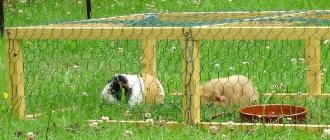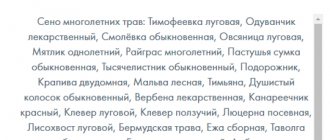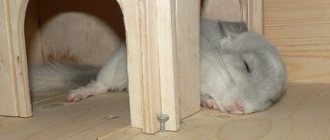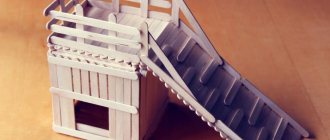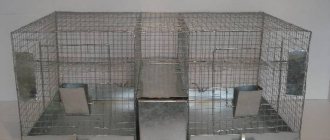The German Shepherd is one of the best breeds for guarding an area. Dogs are brave, loyal, smart and active. Their psychological and physical health depends on the conditions of detention. A large breed needs space and freedom of movement. The most convenient option for a German Shepherd is an outdoor enclosure on the territory of a country house and the possibility of walking. Before building housing for a pet on the site, you need to find out where it is best to build it, how to calculate the size and other subtleties that will make the life of your beloved dog comfortable.
Pros and cons of an aviary for Germans
Keeping a German on the street has many advantages:
- The dog acquires his own personal space, where he feels like a master.
- The Shepherd can relax without worrying about being disturbed.
- The German has a personal guard post from which he can see the territory under his protection.
- For female German Shepherds, raising puppies is comfortable and safe.
- There is no need to keep the animal on a chain.
- Living a pet on the street relieves owners of fur and clutter in the apartment.
There are not many disadvantages from using enclosures:
- It takes time after showing the pet a new place of residence for it to get used to it, stop worrying and not try to leave it.
- The premises will have to be regularly cleaned and equipment replaced.
- It will take time and money to purchase or independently build a dog enclosure that matches the size of the German Shepherd.
Is it possible to keep a shepherd dog outside in winter?
Both short-haired and long-haired German Shepherds have thick fur and a dense undercoat, thanks to which they are not afraid of frost. They can spend the winter outside without any health risks.
Dogs' skin has special glands that produce oil. This fat coats the shepherd's fur, so they can be outside even if the temperature has gone far below zero.
Moreover, this breed really likes to “swim” in the snow. This is how dogs cleanse themselves of impurities.
The temperature at which you should bring a dog into your home depends on the climate. If it is dry, the shepherd can withstand even thirty-degree frost. If the climate is humid, then it is not recommended to keep the dog outside even at fifteen degrees below zero.
IMPORTANT!
Each dog has individual endurance. Pregnant and lactating females should be kept in a warm room; the cold will not benefit them or their puppies.
What kind of enclosure is needed for a German Shepherd in the courtyard of a private house?
In order to create normal conditions for a German Shepherd to live and perform its duties, it is necessary to adhere to the basic requirements regarding the location, area, height of the enclosure and its arrangement.
If a German is adopted as a puppy, it is necessary to take into account the future growth of the service dog and plan buildings based on this. When determining the minimum size of the enclosure, you should take into account the height at the withers of an adult dog:
- for a German with a height of 45-50 cm - 6 m2-8 m2;
- with a height at the withers of 50-60 cm - 8 m2-10 m2;
- above 60 cm - more than 10 m2.
Even the simplest enclosure should consist of an open area, a platform and a kennel. In regions with cold climates, the booth is placed in a “winter house,” which is a room insulated on all sides. It allows you to protect the German from drafts, humidity and frost. The open area has a dirt floor and is needed for a toilet and walking area. The platform is lined with boards to make it comfortable for the dog to lie on.
Relationships with children
Despite the fact that the German Shepherd has a pronounced guard instinct, the dog is absolutely safe for its owner and his household, including children . Dog handlers note the special sociability of representatives of this breed, incredible devotion to their pack, where the shepherd dog includes the leader-owner and his entire family.
The dog treats children, especially babies, with care and affection, as if understanding that they are too defenseless and vulnerable. An adult German Shepherd, having completed a training course and brought up properly, is a faithful friend to teenagers, a nanny-guardian for small children, a wonderful companion and at the same time an unrivaled protector.
Choosing a location for an aviary
An enclosure for a German shepherd must not only be correctly integrated into the landscape of the house, but also a place for it where the dog will be comfortable and safe. The structure is located on a hill where the soil is not swampy and wastewater does not collect. In such a place it will be convenient for a German to view all the surroundings. The area should be protected as much as possible from wind, drafts, precipitation and odors. Trees near the dog's house are welcome; they will shelter the dog from the scorching summer heat.
You cannot install the enclosure near agricultural buildings, cesspools, roads, toilets and garages. The territory under the protection of the German Shepherd is surrounded by a continuous high fence and provided with lighting. Animals that can cause aggression or infect it with infectious diseases should not enter the dog.
Causes of premature death
Accidents happen with irresponsible owners. A dog that runs out of the territory may be poisoned by spoiled or inappropriate food or get hit by passing vehicles. More careful monitoring and care of your pet will help solve this problem.
The main causes of premature death in pets are injuries and past illnesses. also significantly reduce life expectancy . Infectious diseases negatively affect the body, even if they were suffered at an early age. For example, having suffered from hepatitis quite easily in youth, closer to old age the affected liver will remind itself.
Chronic diseases are also dangerous. Occurring quite easily at a young age, worsening at an older age, they cause many problems for the animal.
Material for construction
To build a reliable enclosure with a booth for a German Shepherd, you will need the following materials:
- cement;
- boards and planks made of coniferous trees;
- metal gratings and pipes;
- tiles, ondulin or slate;
- self-tapping screws
The floor is made from boards, raising them above the ground and laying them on a slight slope to make it easier to wash off dirt. They are pre-treated with impregnation against rotting. It is not advisable to pour a cement floor - a dog lying on concrete can become hypothermic and get sick. Corrugated sheeting is not recommended for use on roofs, since it heats up in summer, cools down in winter, and creates a lot of noise when it rains.
Wood or brick is used to install three walls, and a welded or forged lattice is used for the fourth. A chain-link mesh is not suitable, as the German will jump on it and may break the wire and injure his paws.
Drawing and dimensions of the enclosure for the Germans
After a place for the enclosure has been found, you should make a drawing of it with approximate dimensions. They are adjusted as construction progresses, but a mandatory condition must be met - the dimensions of the structure correspond to the size of the dog. The correct design of an enclosure for a German Shepherd, comfortable for it, has an area of 8 m2 or more. If the pet has free range at night throughout the entire territory of the local area, and is only in its premises during the day, then 6 m2 is enough for it.
The type of construction may be different:
- open - with lattice walls;
- closed - “booth within a booth”;
- semi-open - with one or two solid walls.
Regardless of the area, the height of the enclosure for a German shepherd must be at least 180 cm, so that the dog can stand on its hind legs, and it is convenient for the owner to enter, feed and clean the room.
How to properly build an enclosure with your own hands for a German Shepherd?
You can buy a ready-made enclosure with a booth for a German shepherd, but it is cheaper to make it yourself. It is enough to prepare materials and tools, develop a design drawing, choose a suitable location, and apply ingenuity and skills.
Laying the foundation
When constructing a structure, they start with the foundation. To do this, we follow the plan:
- Mark the site.
- A trench about 30 cm deep and 20 cm wide is dug along the perimeter.
- Metal pipes are installed in the corners, deepening them into the ground by 30-50 cm, so that the front ones rise above the surface by 2 m, and the rear ones by 1.8 m.
- The bottom of the trench is covered with a layer of stones up to half the height.
- They make formwork from boards.
- Mix a concrete solution of cement, water, sand and crushed stone in a ratio of 1:1:2:3.
- They pour it into the trench.
- Leave for two days until dry.
- The boards are removed.
Frame
Regardless of what type of enclosure frame for a German shepherd is designed, metal or wooden beams, we must not forget about the door. For safety reasons, it must open inward. Otherwise, the dog may hit its owner out of joy by jumping on it.
The frame is erected according to the scheme:
- Corners (2.5 cm) are welded to the pipes installed at the corners of the foundation at the bottom and top.
- Install the grating or fittings with a spread of no more than 8-10 cm.
- To add strength and rigidity, a metal strip is welded to the middle part.
- Two of the four sides are covered with wooden boards.
Roof
Slate, tiles or ondulin are used for roofing. The latter contributes to maximum sound insulation; the German behaves calmly and is not nervous from noise and impacts on the metal roof. Nails are not used for fastening soft tiles, preferring self-tapping screws.
The roof is made with one or two slopes, so that during rain the water does not stagnate, but quickly drains. Overhangs on the sides are required (the roof is larger than the size of the frame), in this case less water and snow get inside the enclosure. The most budget-friendly and simplest option is a pitched roof.
Insulation
Insulating the entire enclosure is impractical and costly. The booth and the part of the home where the German rests need to be protected from the cold. It is important to choose a material that will make the room warm and cozy.
One of the most popular is mineral wool. It is quite voluminous and is used in a closed area of the structure. In addition to insulation, you will need waterproofing and cladding. Without them, mineral wool will quickly collapse and lose its properties.
It is convenient to line a German Shepherd doghouse with foam plastic. Waterproofing is not needed, but it will have to be lined so that the dog does not destroy it ahead of time.
It is not difficult to insulate with roll insulation.
Felt is the most environmentally friendly and warm material, capable of maintaining temperature and absorbing excess moisture. A booth upholstered in felt will always be dry and warm.
The roof is insulated using fiberboard.
Arrangement and furniture
The design of an enclosure for a German Shepherd is simple and ascetic. Only the most necessary things are placed inside the structure: a doghouse, a bed, bowls for water and food. Feeding containers are placed so that they can be filled and cleaned without going inside. This device will allow you to easily and safely feed the dog when the owner is away. It should be possible to place bowls at different heights, depending on the growth of the pet, especially if it was purchased as a puppy.
In the open part of the pen for a German shepherd, it is advisable to allocate a toilet area - buy ready-made ones that imitate a lawn or lay down a metal sheet with filler for quick cleaning. The lock on the inside and outside of the door must be reliable and strong. A square wooden plank with a side length of 1 m is installed on the flooring.
Particular attention is paid to arranging a booth for a German shepherd. It should be so spacious that an adult dog can lie completely in it, with his paws stretched out. The optimal dimensions of the kennel are height and depth 1 m, width – 1.4 m.
A booth in a semi-open enclosure is installed at the junction of two solid walls, and a hole (0.6 m by 0.4 m) is located on the south or east side. For the winter, it is covered with thick fabric, secured at the top with a strap.
It is advisable to make the roof of the kennel removable to facilitate the process of cleaning it. Since the German loves to lie on it, observing the situation, he will like the flat surface of the kennel roof.
How to care for the enclosure?
When keeping a German Shepherd in an enclosure, you should regularly clean the booth, premises and surrounding area. To reduce humidity and make cleaning easier, sawdust is used as bedding.
The floor in a dog house needs to be swept daily, and the frequency of wet cleaning is once a month. Don't forget about disinfection. The premises are treated with a three percent solution of formalin or creolin monthly in the summer and once a quarter in the winter. Bowls are cleared of food debris and washed thoroughly after each feeding.
The bedding in the booth is changed weekly. In winter, during severe frosts, additional hay is added, and if necessary, the dog is insulated with a blanket, although when kept outdoors, the German Shepherd has a thick and voluminous undercoat, which allows it to withstand serious drops in temperature.
From early spring to late autumn, treatment against ticks is carried out using insecticidal sprays.
It is necessary to monitor the integrity of the structure - to prevent rotting of the wood, rust on the metal, and unscrewing of screws, which could injure the German Shepherd.
Pet's diet in winter
A German Shepherd should receive more nutritious and high-calorie food in winter.
If the owner feeds the pet natural food, then the dose of meat products in the dog’s daily portion should be increased. A small amount of vegetable oil or animal fat is added to the porridge.
When feeding your pet dry food, in winter it is advisable to choose food intended for active sporting dogs. The animal should be fed warmed (not hot) food. Also pour warm water into the shepherd's bowl.
Important: if it is not possible to make food more nutritious, the dosage of food is increased by adding half the usual daily amount of food to the portion.
Strong and resilient, German Shepherds are perfectly adapted to life outside in any weather. But do not forget that both summer and winter the dog needs care and attention, so you should always pay attention to your pet and provide him with comfortable living conditions.
Author's comment: There were problems with general nausea, but it is impossible to change the indicator due to the small amount of text.
